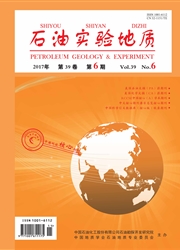

 中文摘要:
中文摘要:
通过牛庄洼陷源岩抽提物异戊二烯烃、单体烃碳同位素和甾、萜烷化合物等多种地化参数的对比,优选出植烷、伽马蜡烷、升藿烷系列、甲藻甾烷和4-甲基甾烷等生标化合物构成源岩特征指纹参数,采用聚类分析方法对沙河街组原油成因类型进行了研究,结果表明该区原油可以划分为3类:Ⅰ类原油与沙三源岩聚为一类,具有低植烷丰度、低伽马蜡烷丰度、低C35升藿烷丰度、低甲藻甾烷丰度和低4-甲基αααC29甾烷丰度的“五低”特点,体现了来源于弱氧化、低盐度环境下形成的沙三下亚段源岩的地化特征;Ⅱ类原油与沙四源岩聚为一类,具有高植烷丰度、高伽马蜡烷丰度、高C35升藿烷丰度、高甲藻甾烷丰度和高4一甲基αααC29甾烷丰度的“五高”特点,体现了来源于强还原、高盐度环境下形成的沙四上亚段源岩地化特征;Ⅲ类原油和沙三、沙四源岩没有显著的聚类关系,也与孔店组原油和源岩地化特征不同.而其主要聚类参数的均值均处于沙三下亚段、沙四上亚段源岩的均值范围之间,推测可能为2套源岩生成原油的混合油。
 英文摘要:
英文摘要:
Multiple geochemical parameters of isoprenoid hydrocarbon, individual hydrocarbon carbon isotope, gonane and terpane in source rock extraction content components from the Niuzhuang sub-Sag were compared. Biomarkers such as phytane, gammacerane, homohopane series dinosterane and 4-methylsteranes were regarded as the fingerprint parameters of source rock features. According to clustering analyses, crude oils from the Shahejie Formation were classified into 3 genetic types as followed. The crude oils of type Ⅰ clustered with the source rocks from the 3rd member of the Shahejie Formation, and were featured by low contents of phytane, gammaeerane, C35 homohopane, dinosterane and 4-methylαααC29 steranes, showing the geochemical characteristics of source rocks in the lower part of the 3rd member of the Shahejie Formation which developed in weak oxidizing and low salinity environment. The crude oils of type Ⅱ clustered with the source rocks from the 4th member of the Shahejie Formation, and were featured by high contents of phytane, gammaeerane, C35 homohopane, dinos- terane and 4-methyl αααC29 steranes, showing the geochemical characteristics of source rocks in the upper part of the 4th member of the Shahejie Formation which developed in strong reducing and high salinity environment. The crude oils of type m had no significant clustering relationship with the source rocks from the 3rd and 4th members of the Shahejie Formation, but the average value of main clustering parameters was in the range of the above-mentioned source rocks, indicating that the crude oils of type Ⅲ might be the mixture of type Ⅰ and Ⅱ.
 同期刊论文项目
同期刊论文项目
 同项目期刊论文
同项目期刊论文
 Characteristics of silty laminae in Zhangjiatan Shale of southeastern Ordos Basin, China: Implicatio
Characteristics of silty laminae in Zhangjiatan Shale of southeastern Ordos Basin, China: Implicatio A Quantitative Method for Characterizing Transport Capability of Compound Hydrocarbon Carrier System
A Quantitative Method for Characterizing Transport Capability of Compound Hydrocarbon Carrier System 期刊信息
期刊信息
